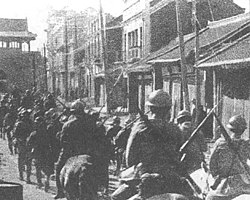Anti-Comintern Pact
The Anti-Comintern Pact,[1] officially the Agreement against the Communist International[2] was an anti-communist pact concluded between Nazi Germany and the Empire of Japan on 25 November 1936 and was directed against the Communist International (Comintern). It was signed by German ambassador-at-large Joachim von Ribbentrop and Japanese ambassador to Germany Kintomo Mushanokōji.[3]: 188–189 Italy joined in 1937 (earlier it had signed the Italo-Soviet Pact[4] directed partly against Hitler), but it was legally recognized as an original signatory by the terms of its entry. Spain and Hungary joined in 1939. Other countries joined during World War II.[5]: 49 The Japanese signatories had hoped that the Anti-Comintern Pact would effectively be an alliance against the Soviet Union, which was how the Soviets perceived it.[6]: 226 There was also a secret additional protocol which specified a joint German-Japanese policy specifically aimed against the Soviet Union.[3]: 188–189 [7]: 197 After August 1939, Japan distanced itself from Germany as a result of the Molotov–Ribbentrop Pact.[6]: 24 [8]: 40 The Anti-Comintern Pact was followed by the September 1940 Tripartite Pact, which identified the United States as the primary threat rather than the Soviet Union (although in theory applying to the Soviets as well[9]: 14 ), however by December 1941 this too was virtually inoperative.[10] The Anti-Comintern Pact was subsequently renewed in November 1941 and saw the entry of several new members into the pact.[5]: 49 The Nazi regime saw signing of the Anti-Comintern Pact as a "litmus test of loyalty".[11] The Anti-Comintern Pact ceased to exist with the end of World War II. Background
Germany"Anti-Komintern" (GDAV)The Anti-Komintern, officially the Gesamtverband Deutscher antikommunistischer Vereinigungen (abbr. GDAV, 'general association of German anti-communist federations'),[12]: 576 was a German agency established by Joseph Goebbels in 1933.[12]: 573 Its activities covered a wide range of operations designed to denounce communism in general and the Soviet Union in particular,[12]: 580 push antisemitic propaganda and garner domestic and international support for Nazi policy.[12]: 574 It was placed under the leadership Dr. Adolf Ehrt [de]. Under Ehrt's leadership, the Comintern was denounced as 'godless' in reference to its atheism.[12]: 581 Beginning in July 1936, the Spanish Civil War became a main focus for the Anti-Komintern's publications.[12]: 580 One of the Anti-Komintern's most significant outputs was the 1936 international release Der Weltbolschewismus, in which it connected various anti-communist and anti-semitic conspiracy theories for the consumption of the international audience. The book was not released in Germany itself to avoid conflict between the book's varied accounts with German state propaganda.[12]: 581 Anglo-German Naval AgreementOn 18 June 1935, the United Kingdom and Germany signed the Anglo-German Naval Agreement, which came as a surprise to the Japanese.[13]: 53 This marked the beginning of a series of attempts by Adolf Hitler to improve relations between the two countries. In Hitler's mind, a positive relationship towards the United Kingdom would weaken Britain's allies France and Italy (at that point still a German rival) and contain the Soviet Union.[14]: 289 Hitler would later also send Ribbentrop to London with the specific task of securing British membership in the Anti-Comintern Pact during his 1936–1938 tenure as German ambassador to the United Kingdom, declaring British accession into the pact as his 'greatest wish'.[15]: 154–155 [16]: 262–263 In Japan, the treaty was viewed with suspicion. Mushanokōji on 4 July 1935 in an embassy meeting[a] stated his opinion that it would be unwise for Japan to rush into an alliance with Germany, as he (correctly) interpreted the Anglo-German Naval Agreement as a German attempt to ally the UK. The United States and Britain had been hostile towards Japan ever since the Mukden Incident of 1931, and Mushanokōji feared that Japan might isolate itself if Germany ended up choosing a partnership with Britain over a partnership with Japan.[13]: 53 Competing authorities and ideologies in German foreign policyThe execution of German foreign policy was nominally left to Konstantin von Neurath's foreign ministry, but Joachim von Ribbentrop headed the semi-autonomous Dienststelle Ribbentrop, created in late 1934,[17]: 14 where he could carry out Hitler's personal foreign policy requests independently from foreign ministry consent. This created a rivalry between the two services.[13]: 62 While Hitler favored Ribbentrop as his personal foreign policy champion, he at least initially maintained Neurath's staff of career diplomats to maximize his government's diplomatic legitimacy abroad.[17]: 12 Hiroshi Ōshima, Japanese military attaché in Berlin and the single most important individual on the Japanese side of the Anti-Comintern Pact's negotiations, interpreted the German foreign service structure as one where the power structure was such that "it was only Hitler and Ribbentrop who decided foreign policy, and that it was therefore of no use to talk to their subordinates". Ōshima thus attempted to get any important step of the negotiations to Ribbentrop's or Hitler's desks directly.[18]: 316–317  While Ribbentrop was Hitler's personal diplomat of choice, his personal view on geostrategic diplomacy varied quite distinctly from Hitler's during the late 1930s. Whereas Hitler favored a friendly policy towards Britain to eliminate the Soviet Union,[15]: 154–155 Ribbentrop saw the western allies as Germany's main enemy and designed much of German foreign policy, including the Anti-Comintern Pact, with the goal to contain the British Empire in mind as well.[19]: 268 When it came to Japan, Ribbentrop believed that the Japanese focus on the Soviet Union as its main antagonist could be redirected towards the United Kingdom also, thus enabling Japan to be a partner in Ribbentrop's anti-British coalition.[19]: 271 German alignment with Japan, against the wishes of the traditionally sinophile German foreign service and German public at large, began at the end of 1933.[20]: 609 German-Soviet interwar treatiesDuring the time of the Weimar Republic, the German government had made major treaties with the USSR, including the 1922 Treaty of Rapallo and the 1926 Treaty of Berlin.[b][21]: 575 Germany was already agitating against the Soviet Union in 1935 when after a previous German–Polish declaration of non-aggression, through Hermann Goring proposed a military alliance with Poland against the Soviet Union, but this was rejected. Germany made later approaches to Poland nevertheless.[22] In a note on the day of the signing of the Anti-Comintern Pact, 25 November 1936, Ribbentrop informed Mushanokōji that the German government viewed these two treaties' terms as void under the secret additional protocol.[7]: 199 Mushanokōji replied on the same day, expressing the Japanese government's "sincere satisfaction" with the German stance.[7]: 199–200 This had been partially a result of the Japanese government's insistence, most notably in a request on 24 July 1936, to clarify the treaty's implications for past bilateral treaties between either party and the Soviet Union.[23]: 33–34 JapanRacial Equality Proposal of 1919, Washington Naval Conference of 1922Japan had fought in the Great War on the side of the victorious Entente Powers. However, as part of the Washington Naval Conference of 1922, the United States and United Kingdom successfully managed to both limit Japan's naval forces by treaty and to force Japan to surrender her gains in China made during World War I. While there were some advantages for Tokyo gained during the conference – it was granted parity with USA and UK in the Pacific Ocean and was entitled to build a navy that would outmatch the French and Italian navies, as well as being recognized as the world's only non-western colonial power – the treaty was unpopular in Japan. Japanese nationalists, as well as the Imperial Japanese Navy, denounced the treaty's restrictive aspects.[24]: 193–194 [25]: 101 Culturally, the 1922 Washington Treaty was viewed as yet another betrayal by the Western powers, after the Japanese proposals for guaranteed racial equality under the League of Nations had been rejected in 1919.[26][25]: 68 This perception of national humiliation was further accelerated by the economic downturn that Japan experienced in the 1920s, exemplified by the 1927 financial panic in Japan (Shōwa financial crisis), which had also caused political instability and the fall of the first cabinet of Reijirō Wakatsuki, and by the 1929 Great Depression.[23]: 9 German historian Bernd Martin dubbed the Washington Naval Conference the "Japanese 'Versailles'."[20]: 607 Japanese societal militarization and aggression against China The Mukden Incident of 18 September 1931 began the period of Japanese aggression in Asia between 1931 and 1945, sometimes called the Fifteen Years War.[27]: 1–2 The diplomatic reaction of the European great powers to Japan's attack against China was insufficient to stop the Japanese advance, despite continued Chinese appeals to the League of Nations. This attack, which had no central order from Tokyo precede it and was rather an autonomous decision by the Kwantung Army leadership,[20]: 608–609 was kept confined to North East China by the Japanese commanders in the hopes that this would be enough to keep European responses lukewarm and thus further Japanese advances. This estimation proved to be accurate, and the United Kingdom in particular was more than happy to let Japan proceed in Manchuria as long as British interests in southern and central China remained undisturbed. Even after the Shanghai Incident of 28 January 1932, the British attitude remained on the whole friendly to the Japanese cause and indifferent towards Chinese pleas for assistance. Among the few exceptions to this were British efforts to bring about peace in the city of Shanghai itself, where the UK had direct economic interests. The Japanese Pacification of Manchukuo on the other hand was viewed in Britain as a positive development that ultimately would help to disperse bandit activity.[27]: 3–6 In February 1932, the Japanese established a puppet state in North East China, the State of Manchuria, nominally headed by Puyi, the dethroned last emperor of the Qing dynasty (r. 1908–1912, 1917).[28]: 65–73 Following the Lytton Report, which laid the blame for the conflict in Manchuria firmly at the feet of the Japanese, Sir John Simon, the foreign secretary of the United Kingdom, failed to condemn Japan in his speech on 7 December 1932, and subsequently earned the favor of Japanese politicians such as Yōsuke Matsuoka, who viewed the lackluster British response as further encouragement for the Japanese course in China. Japan left the League of Nations as a result of the Lytton Report in February 1933.[27]: 6–7 The Tanggu Truce ended the hostilities in Manchuria, but Japanese ambition in China was not yet satisfied. Between 1933 and 1936, Japanese foreign minister Kōki Hirota | ||||||||||||||||||||||||||||||

